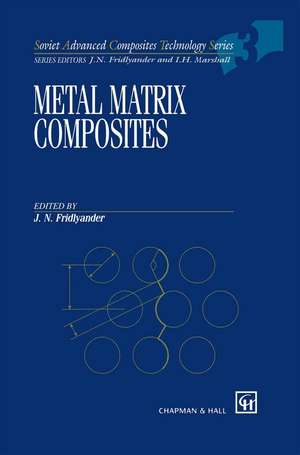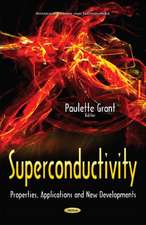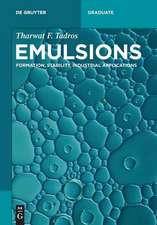Metal Matrix Composites: Soviet Advanced Composites Technology Series, cartea 3
Editat de J. Fridlyanderen Limba Engleză Paperback – 21 oct 2012
| Toate formatele și edițiile | Preț | Express |
|---|---|---|
| Paperback (1) | 3032.79 lei 6-8 săpt. | |
| SPRINGER NETHERLANDS – 21 oct 2012 | 3032.79 lei 6-8 săpt. | |
| Hardback (1) | 3039.25 lei 6-8 săpt. | |
| SPRINGER NETHERLANDS – 31 dec 1994 | 3039.25 lei 6-8 săpt. |
Preț: 3032.79 lei
Preț vechi: 3698.52 lei
-18% Nou
Puncte Express: 4549
Preț estimativ în valută:
580.32€ • 632.35$ • 489.01£
580.32€ • 632.35$ • 489.01£
Carte tipărită la comandă
Livrare economică 23 aprilie-07 mai
Preluare comenzi: 021 569.72.76
Specificații
ISBN-13: 9789401045520
ISBN-10: 9401045526
Pagini: 700
Ilustrații: XI, 682 p.
Dimensiuni: 155 x 235 x 37 mm
Greutate: 0.96 kg
Ediția:1995
Editura: SPRINGER NETHERLANDS
Colecția Springer
Seria Soviet Advanced Composites Technology Series
Locul publicării:Dordrecht, Netherlands
ISBN-10: 9401045526
Pagini: 700
Ilustrații: XI, 682 p.
Dimensiuni: 155 x 235 x 37 mm
Greutate: 0.96 kg
Ediția:1995
Editura: SPRINGER NETHERLANDS
Colecția Springer
Seria Soviet Advanced Composites Technology Series
Locul publicării:Dordrecht, Netherlands
Public țintă
ResearchCuprins
1 Physio-chemical fundamentals of metal matrix composites.- 1.1 Formation of metal matrix composite structure and properties during the production process.- 1.2 Principles of metal matrix composite development and optimization.- 1.3 Conclusions.- References.- 2 Basic components used in the production of metal composites.- 2.1 Fibrous reinforcing agents.- 2.2 Dispersed strengtheners.- 2.3 Matrix alloys.- References.- 3 Metal matrix composite fabrication methods.- 3.1 Solid-phase fabrication methods (V.M. Tchubarov).- 3.2 Liquid-phase fabrication methods (A.A. Zabolotsky).- 3.3 Moulding of structural components from metal composite materials (G.A. Krivov).- Notation.- References.- 4 Composites of the aluminium—boron system.- 4.1 General.- 4.2 Boron—aluminium production procedure.- 4.3 Strength under static load.- 4.4 Strength at elevated temperature.- 4.5 Impact strength.- 4.6 Strength under cyclic load.- 4.7 Employment of boron-aluminium.- References.- 5 Composites of the magnesium-boron system.- 5.1 Obtaining magnesium—boron composite materials by solid-phase combination.- 5.2 Obtaining magnesium-boron composite materials by liquid-phase combination.- 5.3 Corrosion resistance of magnesium-boron composite materials.- Notation.- References.- 6 Composite materials of the aluminium—carbon system.- 6.1 Composite materials based on an aluminium matrix reinforced with carbon fibers (V.I. Kostikov and V.C. Kilin).- 6.2 Aluminium-carbon system composites (A.A. Zabolotsky).- Notation.- References.- 7 Composites of the aluminium—steel system.- 7.1 Selection of fibres.- 7.2 Selection of matrix.- 7.3 Manufacturing techniques.- 7.4 Kinetics of formation and growth of intermetallic compounds on phase boundaries.- 7.5 Properties.- 7.6 Manufacturing of CAS-type material.- 7.7Properties of structural elements.- 7.8 Thermal effects on interaction.- 7.9 Summary.- Notation.- References.- 8 Composite materials of aluminium—silicon carbide system.- 8.1 General.- 8.2 Analysis of composition and morphology of reinforcing fillers and admixture phases.- 8.3 Chemical properties of reinforcing fillers.- 8.4 Purification of reinforcing fillers of admixture phases.- 8.5 Obtaining composite materials by infiltration under pressure.- 8.6 Obtaining materials by methods of powder metallurgy.- 8.7 Prospective uses of Al—SiC composite materials.- References.- 9 Laminated fibrous metal—polymer composites.- 9.1 Introduction.- 9.2 Components of laminated fibrous metal—polymer composites.- 9.3 Properties and specific features of laminated-fibrous metal—polymer composites under static loading.- 9.4 Specific features of fatigue fracture of laminated fibrous metal—polymer composites.- 9.5 Damping properties of laminated fibrous metal—polymer composites.- 9.6 Production of parts and structures from laminated fibrous metal—polymer composites.- 9.7 Resistance of aluminium—organic plastic composites to environmental and corrosive effects.- 9.8 Conclusions.- Notation.- References.- 10 Mechanical testing of composite materials.- 10.1 Tension testing.- 10.2 Compression testing.- 10.3 Shear testing.- 10.4 Crack-resistance testing.- 10.5 Fatigue testing.- Notation.- 11 Theoretical and experimental research into the strength and deformation of fibrous metal composite materials.- 11.1 Materials investigated.- 11.2 Stretching in the reinforcement direction.- 11.3 Compression in the reinforcement direction.- 11.4 Compression perpendicular to the reinforcement.- 11.5 Three-point bending.- 11.6 Cyclic tension in the reinforcement direction.- 11.7 Deformation anddestruction of orthogonally reinforced metal composite materials under tensile stress.- Notation.- References.- 12 Structural micromechanics of elasto-plastic deformation of composites.- 12.1 Induced defects on interfaces.- 12.2 Stress fields of reinforcing fibres.- 12.3 Disinclination formation on edges of faceted reinforcing particles or fibres.- 12.4 Residual stresses elastically heterogeneous plastically deformed materials.- 12.5 Resistance to deformation.- 12.6 Specific energy of internal stresses as damaging factor.- 12.7 Structural levels.- References.












